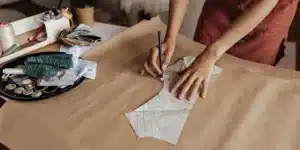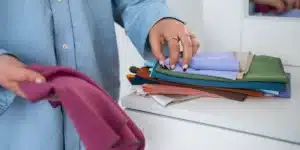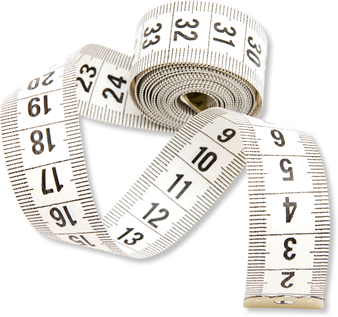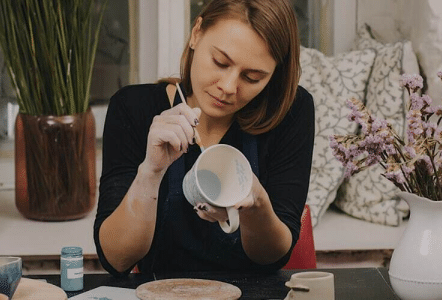Why you should go into the home textile business
Home textile businesses can offer significant business opportunities due to the increase in demand for sustainably made products, innovative designs and customisable options.
If you have a passion for creating different textiles, or you are specialised in just one area, creating a home based textile business is a great way to profit off your skills.
Types of home textiles businesses
Textiles is an extremely broad craft, and it can encompass a wide range of different fibre and fabrics products.
Some common types of home textile business that you may see online include:
- Soft furnishings such as beddings, blankets, pillows and cushion covers.
- Apparel textiles such as clothes, hair accessories and bags.
- Art and homeware such as tapestries, decorative accessories and framed artwork.
- Pet accessories such as collars, leads, toys and bedding.
- Carpets and rugs such as decorative wall rugs, full room carpets and floor rugs.

How much does it cost to start a small textiles business from home?
How much it costs to start a small textile business from home really depends on the type of products you produce and the equipment you need. However, that being said, there are a few standard costs that you can expect to see no matter what type of products you make.
These costs usually include:
- Machinery, such as sewing or embroidery machines
- Fabrics and fabric dyes
- Threads, buttons and zippers
- Website domain name and hosting
- E-commerce platforms
- Postage and packaging
- Marketing and advertising
- Business insurance
- Potential alterations to your home for a home studio
Protect your Textiles Business with Insurance
What you need to start your textiles business from home
To start your textile business from home, there are a few different elements that you will need to get in place, ideally before you start selling.
A home studio
When you’re starting up your textiles business, you will need somewhere in your house where you can make and store all of your products. Although some people may choose to build extensions, convert rooms or add studios to their gardens, it can be as simple as having a specific room in your house that holds all of your equipment.
If you are going to use one of your existing rooms in your house, you may want to consider adding some new furniture, such as a desk and storage units. You don’t need to spend a fortune on this as you can usually find good quality second hand furniture in person and online for reasonable prices.
Branding and marketing plans
No matter what kind of textile products you’re going to make, or how big you expect your business to grow, developing a brand and marketing plan is an essential part of any business.
You will need to decide on your brand name, colour palettes, logos and your overall brand identity. While creating your brand, you should also consider where you would like to sell your products, such as online through an e-commerce site.
The right level of insurance
Insurance is one of the most important elements you should have in place before you start selling your products. Although it isn’t actually considered a legal requirement in the UK, is it essential to protect you and your business should a claim be made against you.
Here at CraftCover, our bespoke textile craft business insurance will protect your products, equipment and business from losses due to damage, accidents or claims made from the public. Without the right level of insurance, a claim against your business could cause huge financial strain.
Our insurance includes two of the most important insurance policies you will need for your textile business:
-
Public Liability Insurance – This insurance will cover the cost of a claim made against your business by members of the public if an accident occurs as a direct result of your business’s practices. It provides legal liability for injury or death to the public, and damage or loss of third party property.
For example, a customer visits your home studio to collect a product, trips over some equipment and becomes injured as a result of this. If they decide to pursue a claim, your business could face significant costs without Public Liability Insurance in place.
- Product Liability Insurance – This type of insurance will protect your business if a customer has an issue with the production, sale and supply of your products. This can also include any repair, service or maintenance works that you may undertake.
For example, if your textile business creates clothes, a claim could be made against you if you have knowingly sold defective items of clothing.
Ensuring the quality of your textile crafts
Inspections are crucial in the textile industry as you must be sure that your products meet specific standards and requirements. To ensure your products are high quality, you should focus on careful material selection, meticulous construction techniques and thorough quality control checks.
Generally speaking, there are a few different steps to ensure the quality of your textile crafts:
- Physical testing – Assess physical attributes, such as elasticity, strength and thickness. This stage determines the durability of the fabric and how suitable it will be for the products you’re making.
-
Chemical testing – You should also evaluate the fabrics reaction to chemicals. This includes testing for resistance against substances like detergents and bleach.
-
Performance testing – Analyse how the fabric lasts under various conditions, such as wear and tear, exposure to sunlight and different washing methods. This step is to ensure the fabric keeps its quality over time.
-
Aesthetic assessment – Check the visual aspects of the product. This includes checking the colour, texture, pattern and overall quality of the fabric.
-
Compliance assessment – You should ensure the fabric meets all of the standards relevant to your industry, such as clothing or homeware. This step includes verifying safety standards, environmental statements and other labels.

Where to sell your handmade textile crafts
There are a huge number of different places you can sell your handmade textile crafts. One of the most common places crafters sell their products is online. While you could create your own e-commerce store, many crafters will use third-party sites selling instead.
Popular online selling sites include:
- Etsy
- Folksy
- Facebook Marketplace
- Depop
- Ebay
Although these sites may be cheaper to sell on than having your own website, it’s worth bearing in mind that some sites charge listing fees or will take a percentage of your sale.
You could also sell your products in person at craft fairs. There are a huge number of markets and fairs across the UK, meaning finding the right one for you shouldn’t be an issue. We can help by providing you with craft fair insurance in your annual insurance policy, or if you prefer, we can provide one-off craft fair insurance while you’re dipping your toes into the world of crafting.
Get a Quote for Textile Business Insurance
Marketing your home textiles business
Social media has become one of the most popular ways for businesses to promote their crafts, and there’s a good reason for it.
Platforms such as Instagram and Tiktok are great ways to easily showcase your products, all while building a community and receiving quick feedback and opinions from your desired customer base.
You can also market your products through traditional ways such as business cards, posters and flyers.





